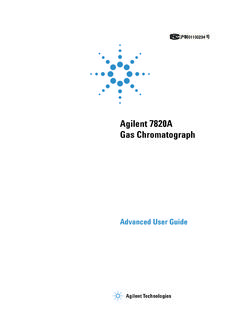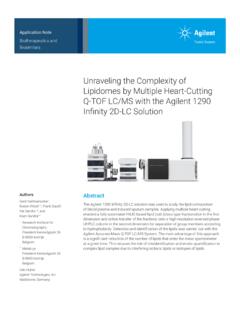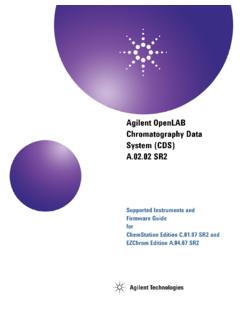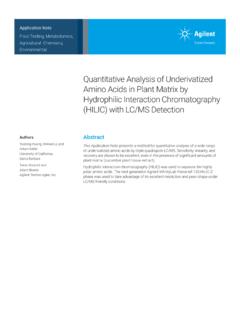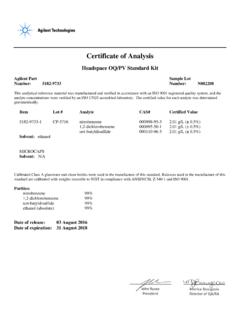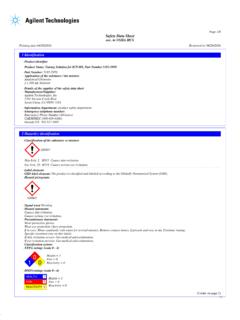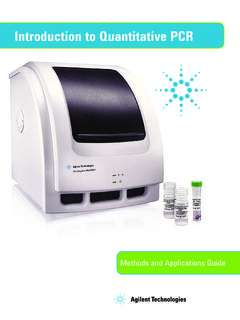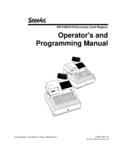Transcription of Multi-elemental determination of gasoline using Agilent ...
1 Multi-elemental determination of gasoline using Agilent 5100 ICP-OES with oxygen injection and a temperature controlled spray chamberApplication noteAuthorsElizabeth Kulikov, Agilent Technologies, Melbourne, AustraliaEnergy & chemicals, petrochemicalsIntroductionIntroductionTr ace metals in gasoline are a major source of environmental pollution. They can also adversely affect the performance of automotive engines. Silicon (Si) contamination can be especially problematic as deposits damage components such as catalytic convertors and oxygen sensors leading to costly repairs. ICP-OES is often used for the determination of trace elements in petroleum products due to its reliability, robustness and sensitivity. A successful analysis needs to take account of sample characteristics, such as the high volatility of gasoline .
2 Continuous loading of the plasma with gasoline can affect the stability of the signal and lead to carbon build up on the torch that may cause the plasma to extinguish. 2In this study, the Agilent 5100 Synchronous Vertical Dual View (SVDV) ICP-OES was used for the analysis of 21 elements in gasoline , including Si. Oxygen was added to the auxiliary argon gas flow to reduce carbon build up on the torch, maintain a stable plasma and reduce carbon emission from the organic solvent. A programmable temperature spray chamber, set to -10 C, was used to reduce vapor loading on the plasma, ensuring a more stable of volatile organic samplesThe 5100 SVDV ICP-OES is highly suited to the analysis of volatile organic samples. It uses a solid state radio frequency (SSRF) system operating at 27 MHz to provide a robust and stable plasma capable of handling a wide range of organic samples, including volatile organics like gasoline .
3 The SSRF has the ability to adjust to rapid changes in the plasma, even when increasing sample uptake speed by fast pumping to 80 rpm. This means that plasma conditions similar to those used for aqueous solutions can be used for organics, without the need for high plasma gas flows. The sample handling capability of the 5100 s vertically-oriented plasma delivers the robustness required for the routine measurement of challenging volatile samples, and ensures maximum plasma stability. The torch is automatically aligned using the simple torch loader and no further adjustments or optical alignments are required. The mechanism also connects all gases for fast startup and reproducible performance. Depending on established methods and application requirements, the 5100 SVDV ICP-OES can be operated in synchronous vertical dual view (SVDV), vertical dual view (VDV), radial (RV) or axial (AV) modes.
4 As gasoline is traditionally measured radially for better sample handling with a vertical torch, the 5100 was operated in RV species present in organic solvents can interfere with some elements. A more accurate measurement of the analyte signal is possible using Agilent s Fast Automated Curve-fitting Technique (FACT) to model the complex background structure due to C-emissions and correct for any spectral interferences [1].ExperimentalInstrumentationThe Agilent 5100 SVDV ICP-OES with temperature controlled spray chamber and oxygen injection was used for the determination of 21 elements in gasoline . The instrument was fitted with the volatile organics sample introduction system consisting of a glass concentric nebulizer, mm RV torch, solvent resistant tubing, and an IsoMist temperature controlled spray chamber.
5 The spray chamber was operated at the minimum temperature of -10 C. An Agilent SPS 4 autosampler was also 5100 SVDV ICP-OES is equipped with a three port gas module. This allows an Ar/O2 gas mix to be routed automatically through the auxiliary gas line to prevent carbon build up on the torch, reduce carbon band emissions and sustain the plasma during analysis. The addition of the Ar/O2 gas mix is fully controlled by the ICP Expert and method parameters used are listed in Table 1a and b. Table 1a. Agilent 5100 ICP-OES operating parametersParameterSettingRead time (s)15 Replicates3 Sample uptake delay (s)30 (fast pumping ON)Stabilization time (s)10 Rinse time (s)45 Pump speed (rpm)10 RF power (W) 1500 Aux flow (L/min) Plasma flow (L/min) Nebulizer flow (L/min) Viewing modeRadialViewing Height (mm)8 Ar/O2 additionYe sAr/O2 (%)15 Background correctionFitted and FACT3 Table 1b.
6 Agilent 5100 ICP-OES sample introduction setupParameterSettingNebulizerGlass SeaSpray Spray chamberIsoMist temperature controlled spray chamber TorchVolatile organics torch with mm ID injector Sample tubingBlack/Black Solva FlexWaste tubingGrey/grey Solva FlexIsoMist temperature ( C)-10 Standards, sample and sample preparationThe method of standard additions (MSA) was used for the analysis to give better accuracy in determining standard and sample concentrations. Complex samples, like gasoline , are difficult to matrix match and must be measured by MSA to minimize physical and chemical differences between samples and standards were prepared at and 1 ppm by spiking aliquots of gasoline with Agilent A21 oil standard (100 ppm in 75 cSt hydrocarbon oil).
7 Agilent base mineral oil (75 cSt mineral oil) was used to match the viscosity of the standards. The solution was then diluted 1 in 10 using Agilent A-SOLV ICP solvent to give a total oil concentration of 10 % (w/w). Premium Unleaded Petrol (PULP) 98 Ron was used as the sample. Approx. g of the gasoline was diluted 1 in 10 (w/w) in Agilent A-SOLV ICP solvent. The solution was matrix matched using Agilent base mineral oil to give a total oil conc. of 10% (w/w).To test the recoveries of all 21 elements in gasoline , the samples diluted in Agilent ICP solvent were spiked with low (approx. ppm) and high (approx. 1 ppm) concentrations of Agilent A21 oil standard. Background correctionIn this analysis, Fast Automated Curve-fitting Technique (FACT) correction was applied to P and Pb to minimize spectral interferences from carbon species present in the organic solvent and to improve detection limits.
8 Table 2 displays the Method Detection Limits (MDLs) for P and Pb obtained using Fitted and FACT background correction. The results show that FACT background correction led to lower DLs. Table 2. Method Detection Limits determined using Fitted and FACT background correction techniquesElement and wavelength (nm)Fitted MDL (ppm)FACT MDL (ppm)P and discussionCalibration linearityLinear calibrations were obtained for all analytes. Calibration coefficients were greater than and the calibration error for each point was less than 10% for all wavelengths. Figure 1 shows the calibration curve for Si nm. Table 3 displays the calibration error for each calibration point for 1. Calibration curve for Si nm shows excellent linearity across the calibrated range, with a correlation coefficient of 3.
9 Calibration error (%) for each calibration point for Si nm StandardCalibration error (%)Reagent 1- 2- shown in Table 4 are based on three sigma of ten replicate measurements of the blank solution. The replicate measurements were multiplied by 10 to account for the 1 in 10 dilution of the original gasoline sample. 4 Table 4. Method Detection Limits for 21 elements in the original gasoline sampleElement & wavelength (nm)MDL (ppm)Element & wavelength (nm)MDL (ppm)Ag 5. Low and high level spike recoveries for all elements in ppm ppm spikeElement & wavelength (nm) gasoline sample (ppm)Measured conc. (ppm)Recovery (%)Measured conc. (ppm)Recovery (%)Ag < < < < < < < < < < < < < < < < < < < < recoveriesAccuracy was checked by spiking a gasoline sample with two different concentration levels ( and ppm).
10 For all analytes, spike recoveries ranged from 98 to 108% (Table 5). The excellent recoveries demonstrate the ability of the 5100 ICP-OES to accurately determine all elements at the required levels in gasoline . Only Si ( mg/kg) was detected in the diluted sample with all other elements being below the detection limit for the method. 5 Long-term stabilityLong term stability (LTS) of the 5100 ICP-OES was measured by continuously analyzing a 1 ppm A21 spiked gasoline sample over an 8 hour period. Over 600 samples were analyzed throughout the entire run, without the need to re-calibrate. The resulting plot for all elements, displayed in Figure 2, shows excellent stability over 8 hours, with recoveries of all elements within 10% of target values.
